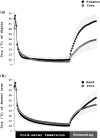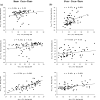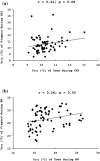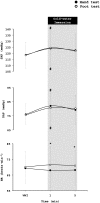No association between hand and foot temperature responses during local cold stress and rewarming
- PMID: 28421275
- PMCID: PMC5427170
- DOI: 10.1007/s00421-017-3601-5
No association between hand and foot temperature responses during local cold stress and rewarming
Abstract
Purpose: The purpose was to examine whether associations exist between temperature responses in the fingers vs. toes and hand vs. foot during local cold-water immersion and rewarming phases.
Methods: Seventy healthy subjects (58 males, 12 females) immersed their right hand or right foot, respectively, in 8 °C water for 30 min (CWI phase), followed by a 15-min spontaneous rewarming (RW) in 25 °C air temperature.
Results: Temperature was lower in the toes than the fingers during the baseline phase (27.8 ± 3.0 vs. 33.9 ± 2.5 °C, p < 0.001), parts of the CWI phase (min 20-30: 8.8 ± 0.7 vs. 9.7 ± 1.4 °C, p < 0.001), and during the RW phase (peak temperature: 22.5 ± 5.1 vs. 32.7 ± 3.6 °C, p < 0.001). Cold-induced vasodilatation (CIVD) was more common in the fingers than in the toes (p < 0.001). Within the first 10 min of CWI, 61% of the subjects exhibited a CIVD response in the fingers, while only 6% of the subjects had a CIVD response in the toes. There was a large variability of temperature responses both within and between extremities, and there was a weak correlation between finger- and toe temperature both during the CWI (r = 0.21, p = 0.08) and the RW phases (r = 0.26, p = 0.03).
Conclusions: Results suggest that there is generally a lower temperature in the toes than the fingers after a short time of local cold exposure and that the thermal responses of the fingers/hands are not readily transferable to the toes/foot.
Keywords: CIVD; Cold tolerance; Finger; Local cold injury; Rewarming; Toe; Water immersion.
Conflict of interest statement
The authors state that there is no personal or financial conflict of interest in the present study.
Figures







Similar articles
-
Finger and toe temperatures on exposure to cold water and cold air.Aviat Space Environ Med. 2008 Oct;79(10):941-6. doi: 10.3357/asem.2258.2008. Aviat Space Environ Med. 2008. PMID: 18856183 Clinical Trial.
-
Cold-induced vasodilatation is not homogenous or generalizable across the hand and feet.Eur J Appl Physiol. 2007 Apr;99(6):701-5. doi: 10.1007/s00421-006-0383-6. Epub 2007 Jan 12. Eur J Appl Physiol. 2007. PMID: 17219169
-
Finger- and toe-temperature responses to local cooling and rewarming have limited predictive value identifying susceptibility to local cold injury-a cohort study in military cadets.Appl Ergon. 2020 Jan;82:102964. doi: 10.1016/j.apergo.2019.102964. Epub 2019 Oct 8. Appl Ergon. 2020. PMID: 31604187
-
Finger cold-induced vasodilation: a review.Eur J Appl Physiol. 2003 Jun;89(5):411-26. doi: 10.1007/s00421-003-0818-2. Epub 2003 Apr 24. Eur J Appl Physiol. 2003. PMID: 12712346 Review.
-
Acral coldness - severely reduced blood flow to fingers and toes.Handb Clin Neurol. 2018;157:677-685. doi: 10.1016/B978-0-444-64074-1.00040-9. Handb Clin Neurol. 2018. PMID: 30459032 Review.
Cited by
-
"Beet" the cold: beetroot juice supplementation improves peripheral blood flow, endothelial function, and anti-inflammatory status in individuals with Raynaud's phenomenon.J Appl Physiol (1985). 2019 Nov 1;127(5):1478-1490. doi: 10.1152/japplphysiol.00292.2019. Epub 2019 Jul 25. J Appl Physiol (1985). 2019. PMID: 31343948 Free PMC article. Clinical Trial.
-
Relation between finger cold-induced vasodilation and rewarming speed after cold exposure.Eur J Appl Physiol. 2019 Jan;119(1):171-180. doi: 10.1007/s00421-018-4012-y. Epub 2018 Oct 16. Eur J Appl Physiol. 2019. PMID: 30327869 Free PMC article.
-
Occupational cold stress and rewarming alters skin temperature thresholds for manual dexterity decrements: An exploratory study.Physiol Rep. 2025 May;13(9):e70342. doi: 10.14814/phy2.70342. Physiol Rep. 2025. PMID: 40343410 Free PMC article.
-
Reproducibility of Skin Temperature Response after Cold Stress Test Using the Game Ready System: Preliminary Study.Int J Environ Res Public Health. 2021 Aug 5;18(16):8295. doi: 10.3390/ijerph18168295. Int J Environ Res Public Health. 2021. PMID: 34444044 Free PMC article.
-
Hesperetin-7-O-glucoside/β-cyclodextrin Inclusion Complex Induces Acute Vasodilator Effect to Inhibit the Cold Sensation Response during Localized Cold-Stimulate Stress in Healthy Human Subjects: A Randomized, Double-Blind, Crossover, and Placebo-Controlled Study.Nutrients. 2023 Aug 24;15(17):3702. doi: 10.3390/nu15173702. Nutrients. 2023. PMID: 37686734 Free PMC article. Clinical Trial.
References
-
- Ahle NW, Buroni JR, Sharp MW, Hamlet MP. Infrared thermographic measurement of circulatory compromise in trenchfoot-injured Argentine soldiers. Aviat Space Environ Med. 1990;61(3):247–250. - PubMed
-
- Amon M (2009) Effect of “sleep high-train low” hypoxic training on cold induced vasodilatation (CIVD) response in fingers and toes. Jozef Stefan International Postgraduate School, Ljubljana, Slovenia
MeSH terms
Substances
LinkOut - more resources
Full Text Sources
Other Literature Sources

